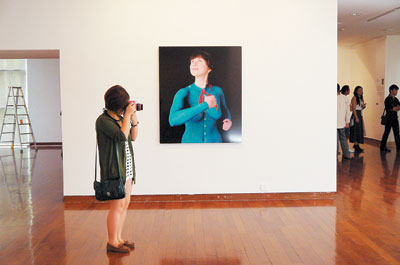
Cao Zhen
caozhen0806@126.com
“LOCAL Futures,” an exhibition showcasing paintings, installations, videos and photographs by 22 young artists living overseas in 13 countries, is displayed at the He Xiangning Art Museum until Nov. 24.
The exhibition focuses on the emotional experiences of overseas Chinese artists living in the United States, Japan, Thailand and Western Europe.
“They have Chinese blood but create their art in foreign countries, so their art is different from art created in China,” said Feng Boyi, a curator of the exhibition. “There are very few exhibitions of the work by these young artists in China, but I believe overseas Chinese artists are an objective phenomenon within the context of cultural globalization.”
An award ceremony was held Sunday night at the museum. Shanghai-born and Japan-based artist Ishu Han received the Prominent New Artist award for “Neighbor,” a video reflecting his insights into political issues. The seven-minute video shows two connected toy tanks moving around. He said the tanks represent the relations of two neighboring countries, which are “neither separated nor dancing together.”
The New Vision award went to New Yorker Casey Tang for his “Mistake Archive,” an installation of several boxes containing documents and goods recording all the mistakes Tang has made since 2009. The Best Creation award was snatched by Singaporean Chen Sai Hua Kuan for “Space Drawing No. 7,” an installation at an abandoned warehouse in Limerick, Ireland, portraying the city’s emptiness.
When entering the exhibition hall, visitors see two similar allegorical installations: “Invasion,” by Indonesian Tintin Wulia, and “Gravity,” by New Yorker Richard Kuan.
In “Invasion,” red threads emerge from flowerpots, pass through a hole in a wall and, on the other side of the wall, connect to kites. Razor blades held up by rare-earth magnets are hung right above the threads. Whether the razor blades will fall and cut the threads depends on the movement of air in the space. Instead of flying freely, the kites are suspended by hooks hanging from the ceiling, preventing them from falling to the ground. The kites are made of photocopies of Wulia’s family members’ citizenship documents.
Born in 1972, Wulia said she grew up as a Chinese minority during the fall of Suharto in 1998. She playfully reflects on the human condition of the geopolitical border within the imbalanced process of globalization.
“The installation is precarious, creating tension. A tiny change can collapse the whole system,” Wulia said. “These identity documents somehow evoke my contrasting feelings. They signify a bond of intimacy to my ancestry and, on the other hand, they bring about feelings of being an outsider, because I have to show the documents whenever my identity is questioned.”
In “Gravity,” a red balloon lingers in the sky, tied down by a black balloon filled with ice. As ice melts into water, the water drains out of the balloon and the red balloon may fly away with the black one.
“Only when we hope for something does it attain some type of gravity,” Kuan said. Curator Feng said museum staff repeatedly fill the black balloon with ice.
“Overseas Chinese always seek self-identity because identity is intimately related to social groups,” said Feng. “They engage in artistic creation based on attitudes and viewpoints formed in foreign cultures.”
In Taiwan-born and New York-based visual artist Fay Ku’s watercolor painting “Safe as Houses,” several half-naked women hide their heads in houses, expressing the idea of suburban housewives and dystopia. Ku said she is interested in family, gender and racial issues and how material culture is physically shaped by inherited ideas in customs and life. Ku researched contemporary Chinese and American abstract paintings and works for the New York Foundation for the Arts.
In Thailand photographer Lek Kiatsirikajorn’s “Lost in Paradise” series, he portrays migrant rural workers in Bangkok.
“Through these images, I aim to present an allegory for modern Thailand: The country as a whole, like these workers, left its past of agriculture behind in search of a better life, but now finds itself trapped between this lost history and a better future that seems to remain just out of reach,” Kiatsirikajorn said.
Because overseas Chinese artists are gradually distancing themselves from cultural memories from their ancestors, Feng said, they are beginning to position themselves against the background of a diverse, globalized culture, and attempting to represent the coexistence of multiple cultures through their art.
“Perhaps this is the ‘local future’ for these artists,” Feng said.
Dates: Until Nov. 24
Hours: 9:30 a.m.-5 p.m. Closed Mondays
Venue: He Xiangning Art Museum, Overseas Chinese Town, Shennan Boulevard, Nanshan District (南山区华侨城何香凝美术馆)
Metro: Luobao Line, OCT Station (华侨城站), Exit C
|

